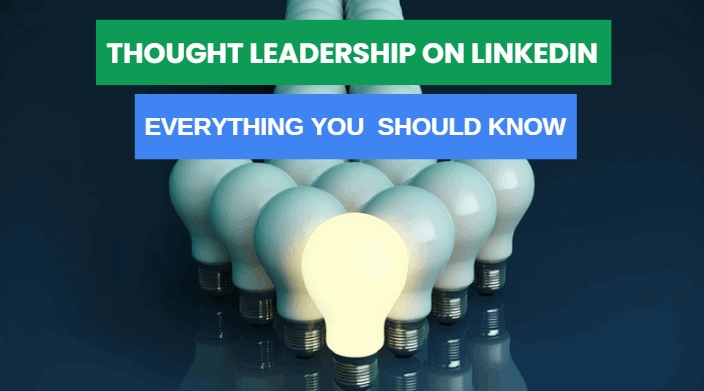Nearly 73% of decision-makers believe that a company’s thought leadership content is more reliable in assessing its capabilities than its marketing material. When you help people with valuable content, you win their trust. And, trust is a powerful driving force when it comes to pushing a prospect down to the bottom of your sales funnel (Where sales happen).
In this post, we’ll talk about using the most popular professional social media platform, Linkedin, for thought leadership. We’ll dive into how to optimize your profile for more visibility, the types of content (and how to create them), and engagement strategies you can use to turn prospects into customers. Let’s dive in.
What is Thought Leadership on LinkedIn?
Thought leadership on LinkedIn starts with creating valuable and helpful content on a particular topic. But, it goes beyond that. It involves sparking conversions around a topic and influencing the decisions of your target market. It refers to producing the type of content that positions you as an authority and elevates your brand’s presence and influence.
Why LinkedIn for Thought Leadership?
Creating and sharing LinkedIn thought leadership can give your brand or business a boost in presence within the industry. With helpful content on in-demand topics, you can easily reach and engage your target market on the platform.
In addition, LinkedIn’s algorithm helps thought-provoking reach more people. And, since most people who use LinkedIn are professionals, you have a better chance of creating meaningful conversations with your content. Moreover, LinkedIn lets you create content in different formats, allowing you to attract and engage your audience in a diverse manner.
Related: What Role Does AI Play in Social Media Marketing?
Developing a Thought Leadership Strategy for LinkedIn

Here’s a step-by-step guide on building thought leadership on LinkedIn.
Optimize Your LinkedIn Profile
Start by making sure your LinkedIn profile is optimized for your target topic and audience. Here’s how to do it:
- Use a professional headshot or your company logo as the profile image
- Write a compelling headline that grabs the attention of your target audience
- Create a comprehensive summary of what you offer and who you help
- Add your skills, experiences, and projects to validate your expertise
- Create a custom URL for your LinkedIn profile
Remember that your LinkedIn profile is like a sales page. Use powerful words and compelling language to convert visitors into customers.
Create Impactful LinkedIn Content
Once your profile is ready, it’s time to attract prospects to it with impactful thought leadership content. To build your authority as a thought leader on LinkedIn, you need to publish high-quality content consistently. You can share how-to guides, industry news, case studies, and personal stories that offer value. LinkedIn lets you create different types of content to engage your audience. Understanding these content types can help you create a content strategy for maximum impact.
LinkedIn Posts

The most popular content format on LinkedIn is posts. LinkedIn posts are easy to create. Purely text-based posts are a great way to spark a conversation, but it can be challenging to drive engagement with them. Thankfully, you can add images or videos to your posts as well to make them visually appealing.
Carefully plan and write your LinkedIn posts to generate the desired result with them. Start by creating an attention-grabbing hook. Something that stops the scroller in their tracks. The content of your post should be valuable and engaging. Avoid writing long blocks of text; use small sentences and paragraphs to make your posts more consumable. LinkedIn posts are great at sparking conversations and sharing valuable information, but they’re not ideal for long-form content. This is where LinkedIn articles come in handy.
Related: Using LinkedIn for Networking
LinkedIn Articles
LinkedIn articles are a perfect content type for thought leadership as they allow you to share in-depth content with your audience. Like any article on a website, you can add links, images, text, and videos within a LinkedIn article. You also have the option to enable comments on your articles for engagement. Probably the only downside to focusing on this content type is the amount of effort it demands. Plus, you get limited design and customization options with a LinkedIn article, which makes owning your own blog a better option.
LinkedIn Newsletter
LinkedIn Newsletter is great for keeping your followers in the loop about the latest things happening in your industry and on your LinkedIn profile. For instance, you can send a newsletter every time you publish a new post. The stand-out benefit of this content type is that you can reach your audience in their inboxes.
Thought Leadership on LinkedIn: FAQs
Here are the most important frequently asked questions on thought leadership on LinkedIn.
What is Thought Leadership Content on LinkedIn?
Thought leadership on LinkedIn involves sharing valuable content on a particular topic with the goal of establishing yourself as an authority on that topic. This includes creating posts, articles, and newsletters to inspire, educate, and engage the audience.
How Do I Position Myself as a Thought Leader on LinkedIn?
You can position yourself as a thought leader by consistently sharing valuable insights on your topic of expertise. Optimizing your profile, interacting with the audience, and engaging with industry discussions also help in building your authority.
How to Measure Thought Leadership on LinkedIn?
You can measure your thought leadership efforts on LinkedIn by tracking important metrics such as likes, comments, and shares. Plus, track your profile views and monitor follower growth to assess your content’s reach and impact.
How Do You Define a Thought Leader?
A thought leader is someone who’s an authority on a particular topic. They inspire others by sharing valuable and insightful content and engaging in meaningful industry discussions.
Conclusion
Thought leadership on LinkedIn is a perfect way to establish yourself as an authority on a topic. By sharing valuable and helpful content, you build your trust, which in turn helps you build a loyal following around your brand. Thought leadership may take time to show results. It’s a long-term marketing strategy. However, it’s more effective at showing a company’s capabilities than marketing content.
You May Also Like: How to Use Storytelling in Marketing?




